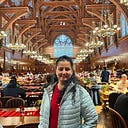I Felt Like I Met Gandhi in Genoa
During my family’s worldschooling sabbatical, we spent a memorable week in the ancient maritime city of Genoa, Italy. Alongside its lure for fresh basil pesto, gorgeous sunsets and old Italian charm, unfortunately, Genoa is also home to an ancient port notorious for its central role in slave trade, and also as the origin-point of Christopher Columbus’ ominous expedition to find (and miss) India.
Surprisingly though, at Port Antico, a life-sized statue of Mahatma Gandhi marching on, adorns the scenery. The day we visited had been a particularly busy one. As my kids hopped away to one of the play structures with Shashank, I took to a nearby bench to rest and enjoy the city glowing in the golden hour. And there, flanked on both the sides by children’s play areas, he stood unassumingly among throngs of kids, parents and strollers.
Soon enough, I noticed a family enthusiastically photographing their kids with Gandhi’s statue. Guessing from the enthusiasm about Gandhi and the family’s African descent, I figured they may have been from South Africa. Gandhi worked as a barrister in South Africa, many years before he would eventually inspire an entire nation to cast off the subjugation that went hand-in-hand with being colonised. The remarkable thing about Gandhi was that he used no other means but his conviction in truth, non-violence and sheer perseverance. In South Africa, Gandhi was the first person to formally question and resist the apartheid. During his lifetime, he led with the simplicity of his soul and the resulting invincible will.
In a few minutes, once the photographing was done, the littlest one in the South African family, probably a preschooler, began to enjoy herself hanging on Gandhi’s hands and his walking stick, using the statue as a play structure. Within a few minutes, two Caucasian girls, most likely of Italian descent and about the same age as hers, joined her in jumping around and hanging from the statue. Initially, this irked me. Couldn’t the city of Genoa put some barricades around the statue — after all, this was a man to whom the world is infinitely indebted and deserves more respect. And who might these inconsiderate parents be who wouldn’t gently nudge their little ones to a play area nearby?
Then something whispered in my mind — what would Gandhi say? Eighty-one years after his passing, an African child and two Caucasian ones, complete strangers, play together as if they’ve known each other for years. They play together not only unencumbered by any city bye-laws, but also unhindered by any psychological baggage about their races. So oblivious to their differences that in that innocent moment, no difference remained. What better place to witness this than here? The statue of the very human being who mustered the courage to question the most powerful imperialists of his day against an institution that had stood cruelly steadfast for centuries — apartheid.
Our next generation swinging by his arms is an ode to his vision of equality of peoples. It is the future’s way to demonstrate that the needle has moved. The subtle yet profound change is beginning to become naturally wired into the modern human psyche, even if it has taken two generations.
Articulated in innocence by these little kids, this moment was the finest evidence of what Gandhi inspired humanity to accomplish, at no better venue than his statue, in a thousand-year-old port which once played a key role in facilitating Trans-Atlantic slave trade. I hardly realised it then, but on that tired evening, I had unexpectedly become a witness to Gandhi’s triumph.
